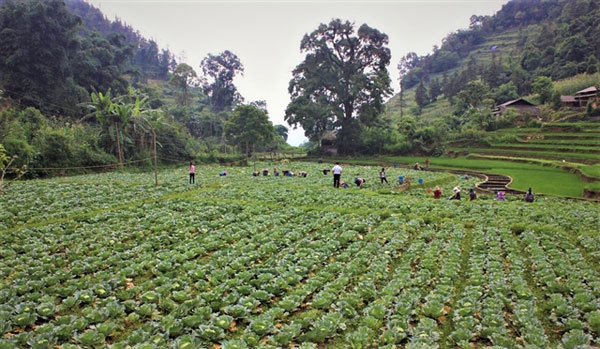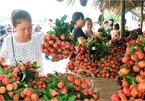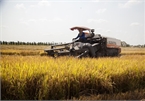 |
| A cabbage field in Muong Khuong District, the northern mountainous province of Lao Cai. — VNA/VNS Photo Huong Thu |
China has just experienced a severe flood, causing a shortage of vegetables, Cuong told the meeting reviewing the winter crop in 2019 and implementation of this year's crop in the northern region.
“Since earlier this year, the agricultural sector had been exposed to double risks of the COVID-19 pandemic and epidemics in livestock and poultry, as well as natural disasters,” said Cuong.
“In such circumstances, the agricultural sector set two goals to organise the production of food for 100 million people and meet export demand,” the minister said.
So far, total cultivated area of 6.7 million hectares had been planted, he said.
“The most important tasks for farmers in the northern provinces was to focus on producing the winter crop, because of favourable natural conditions in 31 provinces and cities who experience cold winters, which could be considered an advantage for agricultural production,” Cuong said.
“The winter crop has short production time but high economic value and is less affected by natural disasters and pests. If the production was well organised, reaping VND200-300 million (US$8,600-13,000) per hectare was possible," he said.
"Moreover, China has been facing rain and flooding, so they are suffering a shortage of food, especially vegetables. We need to take advantage to enhance cultivation for export,” Cuong said.
Cuong suggested local governments actively choose the plant variety structure, convert rice land and saline areas to promote the production of the crop.
He also asked businesses to help farmers sell their agricultural products as well as recommended provincial People’s Committees to issue mechanisms and policies supporting farmers in trade promotion, market research, and encouraging enterprises to sign contracts to purchase products and support branding and traceability to ensure product quality.
The ministry sets a target of increasing this year’s winter-spring crop area to 430,000-450,000ha, rising 20 per cent compared to last year’s crop, while the yield was expected to reach 4.6-4.9 million tonnes, increasing 10-15 per cent against previous years.
The total production value was expected to reach about VND34-36 billion (US$1.5-1.6 million) or VND75 million (US$3.200) per ha.
Corn, sweet potatoes, soybeans, peanuts, and other vegetables will account for about 55 per cent, while potatoes and legumes is about 45 per cent.
According to Nguyen Nhu Cuong, head of the ministry’s Plant Department, each province will consider the harvested area, water source, soil conditions and market to produce the crop to ensure the highest economic efficiency.
The provinces should focus on plating corn for animal husbandry. The department’s figures showed that the corn demand for cattle breeding is 27.6 million tonnes per year.
Dang Ngoc Son, vice chairman of Ha Tinh People's Committee, said enhancement of growing corn for animal breeding would help increase large-scale husbandry, promoting crop restructuring, and enhance links between businesses and farmers. VNS

Vietnam's veggie, fruit exports exceed US$1.5 billion in H1
Exports of vegetable and fruits fetched more than 1.5 billion USD in the first six months of the year, a year-on-year decline of 14.5 percent, according to the Ministry of Agriculture and Rural Development.

Rosy signs show bright prospect for rice export
Vietnam is enjoying strong growth in both rice export volume and value, and more export chances are still ahead as some FTAs have come into force and consumers around the globe are boosting purchase to ensure food security.